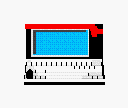
 An
expert system is a computer program capable of considering a vast body of
knowledge, reasoning, and then recommending a course of action.
An
expert system is a computer program capable of considering a vast body of
knowledge, reasoning, and then recommending a course of action.
The major difference between the modern technology of expert systems versus classical algorithmic techniques is the ability to develop systems that infer answers from complex and incomplete knowledge bases. In other words, just as an acceptable answer -- although not necessarily the optimal answer -- can be determined by a human, given incomplete and perhaps unrelated facts, an expert system can be made to choose rational and perhaps multiple answers from a set of rules and facts.
Perhaps the easiest description of an expert system comes from Digital Equipment Corporation's XCON. This system is used to configure complex computer systems and was once referred to as R-1 (as in "we are one"). R-1 was the short hand answer to the question "What is an expert system?" and was developed in 1980. The first expert system was developed by Edward Shortliffe in 1975. The HAL computer of "2001" is a well-known example of a futuristic expert system.
The Decision Maker expert system consists of an explanation portion, a knowledge acquisition portion, a database portion, and a report portion.
The explanation portion of the expert system software displays a decision tree to assist the user in determining why a question is being asked or a solution has been identified. The decision tree (explanation ) model for the system can be found in Robert Tannenbaum and Warren Schmidts's work which appeared in Harvard Business Review in 1954, and in the books "Leadership and Decision Making" by Victor Vroom and Philip Yetton from University of Pittsburgh Press, 1971 and Victor Vroom and Arthur Jago's "The New Leadership - Managing Participation in Organizations" from Prentice Hall, 1988. The tree used in the Decision Maker expert system can be displayed by selecting Analysis Decision Tree - Show Why.
The knowledge acquisition (Consult) portion of the Decision Maker expert system asks the user
questions according to a depth first search strategy. A solution is assumed and the knowledge
acquisition portion of the software determines if a question response is necessary to prove or
disprove the solution. Only questions relevant to the rule are asked and no question is asked
unless it is required to reach a solution. Simple "Yes" of "No" responses are accepted or a
question may be answered with a degree of certainty. Fuzzy logic is then used in the search for
solution(s)
The database consists of abstracts from books and articles involving decision making, leadership,
and management. It allows reading in non sequential ways, meaning that you can drill down on
the exact abstract of interest by either searching on a key word or phrase, by finding a string,
selecting a highlighted word or phrase, or through a browse tree. The software includes hypertext
with context sensitive help.
The report portion includes a text editor and the ability to manage filed reports. Prior to report generation, the user is asked if the leader being analyzed is willing to risk failure to gain efficiency. As in other questions, a degree of certainty may be entered for the response. In this manner, a threshold is established beyond which solutions would be rejected by a risk adverse leader.
The user benefits when new facts and assumptions require re-analysis of the conclusions and recommendations in the draft report. The report is "smart" because the additional facts and changes in assumptions cause appropriated changes in conclusions and recommendations.
For additional information see:
http://www.byte.com/art/9601/sec17/art1.htm (MBAware)
|
|
|
|
|
http://www.eskimo.com/~mighetto/lsexpert.htm - last update August 15, 2000.
 |
This topic is included in Decision Maker's smart database. Select the icon to display an image. |